Whether you’re an athlete sprinting towards the finish line or someone who took an unexpected tumble, a sudden jolt of pain in your hip can bring you to a standstill. The sharp, intense discomfort might be a sign of a hip pointer injury—a common but often overlooked ailment. While it might not be as talked about as a sprained ankle or a pulled muscle, it’s every bit as debilitating, especially when left unaddressed.
In this guide, we’ll explore the ins and outs of hip pointer injuries, ensuring that by the end, you’ll be equipped with knowledge not only to understand this injury better but also to embark on a smooth road to recovery.
Contents
What Is A Hip Pointer?
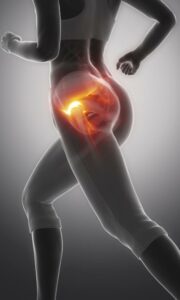 A hip pointer isn’t just a fancy term tossed around in sports medicine clinics; it refers to a specific and rather painful injury that affects the iliac crest of the pelvis. In simpler terms, the iliac crest is the prominent, curved ridge at the top edge of the hip bone, which you can feel jutting out slightly when you place your hands on your waist.
A hip pointer isn’t just a fancy term tossed around in sports medicine clinics; it refers to a specific and rather painful injury that affects the iliac crest of the pelvis. In simpler terms, the iliac crest is the prominent, curved ridge at the top edge of the hip bone, which you can feel jutting out slightly when you place your hands on your waist.
Hip pointer injuries commonly stem from:
- Direct Blows: Often seen in contact sports, an accidental elbow, knee, or even a collision with another player can lead to a direct impact on the hip, causing bruising or injury to the iliac crest.
- Falls: Whether on the sports field, while cycling, or during everyday activities, a hard fall onto the side can lead to this injury. The direct impact of the ground on the hip region can be strong enough to cause the injury.
- Sudden Impact Sports: Sports like football, hockey, or rugby, which involve abrupt changes in direction, speed, and collisions, are common culprits behind hip pointer injuries. The rapid movements and potential for sudden impact increase the risk.
When such forceful impacts occur, they can lead to bruising, muscle strains, or even fractures in severe cases. The pain associated with a hip pointer can be sharp and intense, especially during movements. But understanding the nature of the injury is the first step towards a successful recovery.
Recognizing the Symptoms
The aftermath of sustaining a hip pointer injury can be distinctly noticeable, and for anyone who has experienced it, they’ll attest to its immediate discomfort. While each individual may exhibit slight variations in the intensity and range of symptoms, there are several hallmark signs that typically suggest a hip pointer injury. Here’s what to look out for:
- Pain: The most immediate and apparent symptom is a sharp, intense pain at the site of the injury, especially on the upper part of the hip.
- Swelling: Following the injury, it’s common to notice swelling around the affected area.
- Bruising: Given the impact that causes hip pointers, it’s no surprise that bruising often appears. Depending on the severity, the bruising might start as a red or purplish mark and can change to a green or yellowish hue over time as it heals.
- Limited Range of Motion: The pain and swelling can severely limit one’s ability to move the affected hip. Movements such as bending over, twisting the body, or lifting the leg can become challenging and painful.
- Tenderness to Touch: The injured area will often be tender to touch, with even light pressure inducing pain.
- Muscle Stiffness: Adjacent to the injury, the muscles may become stiff or even go into spasm, creating an additional source of discomfort.
Recognizing these symptoms early on is crucial. A hip pointer might seem like a mere inconvenience at first, but left unattended, it can lead to prolonged pain and complications.
Effective Treatment Options
Experiencing a hip pointer injury can be quite distressing, especially given the sharp, immediate pain it often brings. But, with the right care and treatment approach, recovery can be smooth and relatively swift. Whether you’re looking to alleviate immediate discomfort or seeking longer-term solutions, here’s a comprehensive guide on treating a hip pointer:
At-Home Treatments

- R.I.C.E Protocol: This is the first line of treatment for many minor injuries, and it’s no different for a hip pointer.
- Rest: Give your injured hip a break. Avoid activities that exacerbate the pain or put additional strain on the area.
- Ice: Apply an ice pack to the injured area for 20 minutes at a time, several times a day. This helps reduce swelling and numb the area, offering relief from pain.
- Compression: Wrapping the injured hip with a compression bandage can help minimize swelling. Ensure it’s snug but not too tight to cut off circulation.
- Elevation: If possible, try to elevate the hip. This helps to reduce swelling by allowing fluids to drain away from the injured area.
- Over-the-Counter Pain Relievers: Non-prescription pain medications like ibuprofen or acetaminophen can help reduce pain and inflammation. However, always consult with a healthcare professional before starting any medication.
- Gentle Movement: After the initial phase of the injury, gentle movement and stretching can help prevent stiffness and maintain flexibility.
Professional Interventions

- Physical Therapy: Engaging in physical therapy can be instrumental in the recovery process. A trained therapist can provide specific exercises to strengthen the muscles around the hip, enhance mobility, and ensure proper healing.
- Pain Management Techniques: In cases of severe pain, professionals might use techniques like ultrasound therapy or electric stimulation to manage and reduce pain levels.
- Corticosteroid Injections: In certain cases, if the pain and inflammation are persistent, a healthcare provider might recommend a corticosteroid injection to provide relief.
- Protective Padding: For athletes or individuals keen on returning to physical activity, protective padding can be beneficial. It helps shield the hip from further injury while participating in sports or other strenuous activities.
- Guided Rehabilitation: A tailored rehabilitation program, designed considering the severity of the injury and individual requirements, can be a game-changer in expediting recovery.
While at-home treatments can be effective in managing mild cases, it’s essential to listen to your body. If you’re finding little to no relief or if the pain persists or worsens, seeking professional advice is crucial. They can offer a more in-depth evaluation and guide you towards the most effective treatment options for your specific situation.
Rehabilitation and Strengthening Exercises
Rehabilitating after a hip pointer injury is crucial not only for recovery but also for ensuring the hip becomes stronger and more resilient to future injuries. Here’s a list of some exercises that can aid in this process. As always, it’s essential to consult with a physical therapist or healthcare professional before beginning any exercise routine, especially after an injury.
Bridge Exercise
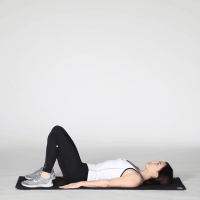
- How to: Lie on your back with knees bent and feet flat on the ground, hip-width apart. Keeping your arms at your side, push through your heels and lift your hips towards the ceiling. Hold for a few seconds, then slowly lower your hips back to the starting position.
Standing Hip Extension
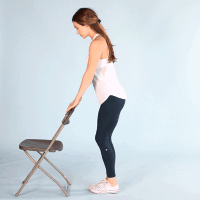
- How to: Stand straight holding onto a stable surface, like a chair or table. Extend one leg straight back without arching your back. Bring it back to the starting position.
Hip Abduction
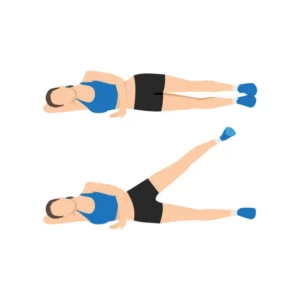
- How to: Lie on your side with your legs stacked. Keep the bottom leg bent for stability and lift the top leg up towards the ceiling without moving your pelvis. Lower it back down with control.
Clamshells
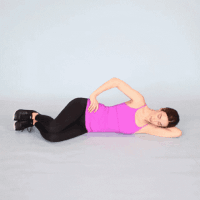
- How to: Lie on your side with legs bent at a 90-degree angle, feet together. Keeping feet touching, lift the top knee as high as possible without moving your pelvis. Lower it back down.
Quadruped Hip Circles
- How to: Start on your hands and knees in a tabletop position. Lift one leg and move it in a circular motion, both clockwise and counter-clockwise. Repeat on the other side.
Piriformis Stretch
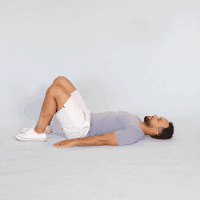
- How to: Sit on the ground and cross the injured leg over the other knee. Hold the knee of the injured leg with the opposite hand and gently pull towards the opposite shoulder. Hold for 20-30 seconds.
Iliotibial Band (ITB) Stretch

- How to: Stand next to a wall for support. Cross the injured leg behind the other leg, keeping both feet on the ground. Lean towards the uninjured side until a stretch is felt on the outside of the hip. Hold for 20-30 seconds.
Remember, consistency is key when it comes to rehabilitation exercises. But it’s equally important to ensure you’re performing these exercises with proper form to prevent further injury. It’s always beneficial to consult a physical therapist who can provide guidance tailored to your specific needs and recovery stage.
The Healing Time: What to Expect
Recovering from a hip pointer injury can be a journey filled with moments of progress and, at times, periods of frustration. Everyone’s body is unique, and the healing timeline may vary based on the severity of the injury, personal health factors, and the quality of immediate care received post-injury. Here’s a general idea of what you can expect during the recovery process:
0-72 hours post-injury: This phase is characterized by intense pain, especially when trying to use the injured hip. You’ll likely experience swelling, bruising, and tenderness in the affected area.
3 days – 2 weeks post-injury: The initial pain starts to subside, but the area can still be tender, especially during certain movements. The bruising might change colors as it begins to heal.
2 – 6 weeks post-injury: Noticeable improvements in pain and mobility. However, sudden movements or accidental knocks to the hip might cause temporary spikes in discomfort.
6 weeks onward: The pain has largely subsided, and now the focus shifts to regaining full strength and mobility in the hip. Some minor discomfort might be felt after rigorous exercises.
Full Recovery: Return to pre-injury levels of activity with no pain or discomfort. The hip feels strong and stable.
Remember, these timelines are general estimates, and individual experiences can vary. If your symptoms aren’t improving as you’d expect or if you experience prolonged pain or discomfort, it’s vital to consult a medical professional.
Conclusion
Hip pointer injuries, while common, should never be taken lightly. Their impact on mobility and daily life can be significant, but with the right care, recovery is achievable. Remember, it’s not just about healing; it’s about regaining strength and preventing future injuries. If you’re experiencing Hip pain, physical therapy for hip pain at PhysioMantra can help: Book an online physical therapy session.



